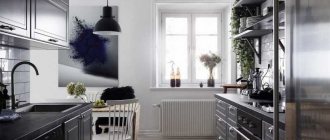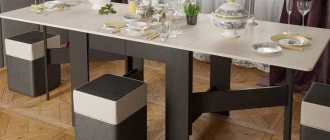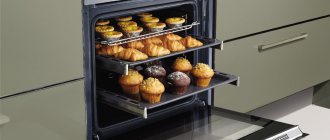Organization of the kitchen area is one of the main issues for every housewife. With minimal space, placing kitchen utensils can be a real problem. One of the main requirements is the provision of lids for pots, which occupy the main space of the workplace. For economical and efficient storage, several options for stands can be useful, which you can make yourself.
There are things that should be in the kitchen of any housewife.
These include a holder for pot lids, which helps keep the lids of all kitchen utensils clean, dry and in the right order.
Storage methods
For economical placement, the best option would be homemade pot lid stands. This will help not only organize space, but also significantly reduce financial costs.
These stands come in different shapes and configurations.
Storage methods:
- horizontal placement;
- vertical placement;
- table stands made from scrap materials;
- organization of work space on shelves;
- making hangers;
- hanging shelves;
- retractable container.
Only by knowing how to store pot lids can you achieve the highest level of order in the kitchen.
Using these methods, you can place lids not only for pots, but also for pans.
Keeping pot lids in a separate place helps keep the kitchen quiet when removing pots from the cabinet.
Horizontal storage
This option is suitable for spacious kitchens with a large number of additional drawers and organizers in the set. Lids are placed on the upper shelves, while the lower floors are occupied by pots or pans.
Because the lids are round in shape, they often fall off, creating a clattering sound.
Proper storage helps prevent excessive noise.
Another option is to place the lids on top of the pans themselves. In this case, the utensils are folded into each other, like nesting dolls, the lids are placed on top, with the handle inward.
Storing dishes and accessories is a pressing issue for housewives.
Lids, handles, holders are only a small part of the necessary accessories.
Reference. This storage method is suitable for placing a small amount of dishes.
You can save space by using hooks. They are located on the lower walls of wall cabinets. Thus, it is possible to place a large number of lids with a handle in the form of loops.
Often it is not possible to distribute all the kitchen utensils throughout the kitchen due to the fact that there is just not enough space.
The kitchen is replete with many little things, for which a special place is allocated.
Vertical storage
Vertical organization is a suitable method for a small work area. This storage has several methods, which allows you to make the best choice and significantly free up additional space in the kitchen.
It is important that they are organized - it makes cooking or cleaning easier.
The main principle is that everything is at hand, but not in the way.
Inside the kitchen cabinet
The main feature of this method, which occurs quite often, is the secrecy of objects. This way the kitchen remains tidy. To use this option, you need to take into account the size of the cabinet and expected finances.
The main advantage is that you can do it yourself.
Railings
The most common option is roof rails, which can be mounted both on the wall and on the doors of the unit. They are easy to use and have an affordable price, excellent price-quality ratio. The range of such accessories is wide, and you can build on your own desires.
First you need to measure the surface area that will be used for fastening, and only then choose the railing material and type of fastening. Screwing is carried out using special elements selected individually. Immediately after installation, you can hang pot lids, which is very convenient - you don’t have to waste time looking for them.
We suggest you read: Cleaning an apartment after renovation, where to start
Many housewives neglect the holders and store the lids on the pans themselves. It's quick and easy, but takes up a lot of space.
In addition to taking up even more space, this is unfavorable for lids with protruding handles. They get scratched and lose their attractive appearance, and an unstable structure is created from a mountain of lids, which crumbles when the door is opened, creating even more trouble for the owner.
If the containers are difficult to fold into a nesting doll, then make additional shelves. To do this, you can purchase a shelf with legs or make them yourself. By installing the product in a table drawer, you can get an additional tier for storing pots and pans.
A corner cabinet is often reserved for storing pots. It is not very convenient for small items, but large dishes will feel great there.
On the tiered shelf you can put different pots, pans and lids for them. When turning, you can easily reach the dishes in the depths of the drawer.
Options
Most desktop stands are small trays with several spacious compartments. It can be placed either on the table or hidden inside a drawer or table. When making organizers, manufacturers use plastic or metal, less often wood. The holders themselves are made in the form of containers or small racks with several sections.
Often there is not enough space for utensil accessories such as lids for pots and pans.
Different sizes and dimensions do not allow them to be placed in a stack, as is the case with plates.
Advice. The organizer is also useful for placing cutting boards.
Placing on shelves or base cabinets is the most spacious and economical storage method. To complete the complete set, you will need a separate box, preferably a floor one. An addition would be stands or racks for lids.
Many people store the lids directly on the pots, which is sometimes not very practical - this way the utensils take up more space.
As an alternative, small single-deck plate drying racks can be used. This design is also useful when arranging the main cabinet for drying plates and mugs. The rack can be placed on the same shelf as the main drying floors.
Purchasing a holder for pans and lids is very important.
Wall racks are a suitable option when saving work space. These hangers for storing pot lids have a number of compartments. Manufacturers offer a wide range of models, which will allow you to choose the product that is optimal in size and capacity.
There are many types of additional storage places, but a stand for pans and lids is especially relevant.
Storage rails for walls and cabinet doors have gained widespread popularity recently. This method involves the use of a special system with several rows of shelves or hooks. Rails are placed under cabinets, on the wall or doors. Lids with a loop handle can be hung on a hook. Place the remaining attributes on the shelves.
A stand designed for folding round and flat objects can help with placement.
The main difference between this option is the ability to make an organizer with your own hands. For manufacturing, you will need a strip of the desired size and hooks. They are installed on a rail, the frame itself is attached to the wall or door of the set using bolts. Many housewives decorate the body of the frame using decoupage or painting techniques. This will help create a practical and unique household item in the interior.
A pot lid holder is a fairly simple device.
Note. In a similar way, you can place cutlery used in the cooking process: spatulas, whisks, ladles, skimmers.
If there is no space at all, then a hanging holder is the best option.
Hanging shelves with dividers are similar in design to wall racks. The main difference is the large capacity - the shelves have several rows. This allows you to comfortably place all the lids that are available in the kitchen. A similar shelf can be hung on a cabinet or wall. Despite its capacity, this storage option is small in size.
This will help save work area and free up additional space in the kitchen.
Addition. With dense rows, many housewives use such shelves to store shallow plates and small pans.
Modern kitchen sets are already equipped with storage systems for lids.
Rails as a shelf for lids
If it is not possible to place the stand on a table or other surface, then you can make shelves. They can be placed either on the wall or on the inside of the door. To create roof rails you will need the following:
- a long rail, all the lids should fit on it;
- 2 short slats will be the legs to which the long one will be attached;
- level;
- screwdriver;
- 2 screws.
We suggest you familiarize yourself with how and at what temperature satin is washed
Stages of work:
- First, the surface where the shelf will be located is determined. Then the markings are applied. IMPORTANT. It is better to draw a line on how the shelf will be attached. This will make it easier to level it.
- The level checks the markings.
- The legs are connected to a large rail, and the entire structure is fastened with self-tapping screws. IMPORTANT. You need to correctly calculate the length of the legs so that the lids cling to the long rail and hold on.
The slats need to be taken so that they can withstand the load, but at the same time do not look too rough.
Types of stands
The stand for pot lids should be installed both on the external surfaces of kitchen tables and on the internal surfaces of the cabinet. Depending on the chosen location, the mounting method and holders differ. Each of these types has its own advantages as well as disadvantages.
Outside
Outdoor stand options are the most practical and also the most commonly used. They are distinguished by a wide variety of models; they also have specific purposes. They are made exclusively for lids or for combined storage with other kitchen appliances.
For lid and spoons
Cutlery should be stored together with lids on stands. The most popular materials for making stands are:
- stainless steel;
- plastic;
- glass.
Plastic stands are less durable and reliable, but are easy to use. They are distinguished by a wide variety of models. Stainless steel stands look more presentable, but if not properly cared for, they quickly become covered with plaque. Such supplies must be removed at least once a week to ensure they are thoroughly washed.
Often such organizers look like this:
- There is a main central compartment for storing lids;
- On the sides there are one or more sections for storing spoons, forks, knives;
- Some options include the ability to store cups with hooks.
Glass stands are rarely used. They look beautiful, but are not very practical. In addition, there are very few models.
Tabletop for several lids and other utensils
Extended stands with the ability to store other utensils are practical if there is no space in the kitchen to store boards and pans. The most common materials for making such stands are:
- stainless steel;
- tree;
- glass.
Depending on the size of the stand, the possibility of simultaneously storing different kitchen utensils is determined. In addition to its main purpose, such an organizer is used for:
- frying pans;
- boards;
- trays;
- large dishes and plates.
This type of stand requires a lot of space. However, if it is not possible to place a large number of different organizers and holders in the kitchen, such as those described above partially solve the problem. The ability to store most kitchen utensils together makes kitchen maintenance easier.
Regardless of the size and material of manufacture, all dishes must be removed from the holders at least once every two weeks and washed thoroughly. All holders can be washed with regular dishwashing detergent. It is recommended to stack dishes only when they are clean and dry.
Railings
Rails offer different mounting options. In addition, they should be installed in any convenient position, and the location of the covers will change. This holder has the following advantages:
- Ability to change location;
- Possibility to mount in any convenient place;
- Possibility to use for storing not only lids;
- Possibility of mounting both on external shelves and cabinets, and on internal ones;
- Possibility to make the railing yourself.
The above list of advantages has made railing quite popular. However, they also have a number of disadvantages:
- Since there is only one fastening, covers of different thickness and diameter may be in an awkward position;
- High cost of finished products.
After weighing all the pros and cons, everyone decides for themselves whether it is worth using a rail to store a frying pan lid in a closet or not. Depending on a number of factors, it turns out to be both practical and impractical. In some cases, it is advisable to replace the railing with a presentation.
Inside
Storing lids inside drawers and cabinets is convenient and practical. Without taking up space, they remain clean. Different stands offer different storage options.
On the closet door
An additional shelf mounted on the inner surfaces of the cabinet is intended for roof storage. This stand takes up space in the closet, although it is attached to the lid. You cannot store anything on the shelf located opposite the inner door.
However, all kitchen utensils are hidden from human eyes. This is a significant plus, especially when decorating a kitchen in a certain style. It is recommended to use this method both in spacious kitchens and in small ones with a small number of tables and cabinets.
Pull-out containers
Retractable containers are installed in furniture during creation. They can be made of plastic or steel, or wood. Some of these containers are designed to hold only pans and pot lids. Others designed for joint storage of spatulas, spoons, lids and other kitchen utensils.
Some containers turn out to be impractical due to poor location planning. For this reason, experts recommend designing such an installation yourself. It can be difficult to implement an idea, but with proper planning, the effort spent will help keep your kitchen utensils clean and tidy.
In the box
Storing any utensils in a drawer requires the presence of internal installations that hold the utensils in the correct position. You can create such installations yourself using dividers and hooks. You should buy stands and install them in the box. This measure will allow you to store kitchen utensils closed from prying eyes, while at the same time organizing them and using them strictly for their intended purpose.
The advantage would be to use large retractable drawers. Those that open using the wraparound method are not practical and do not hold dishes placed on them. It is recommended to use a separate stand for each type of kitchen utensil.
Dryers
Dryers are designed for short-term storage of wet kitchen utensils. They are placed above the sink or above the drain pan. The liquid is poured out of it daily, and it is washed with running water. It is recommended to store dishes on such dryers until they are completely dry.
Some housewives use dryers not for temporary, but for permanent storage of kitchen utensils. This option is acceptable in small kitchens where it is not possible to install additional stands or organizers. If the housewife wipes every detail, there is no need to use a dryer. The dryer turns out to be a practical and convenient solution, giving the dishes the opportunity to dry on their own
Organizers
Organizers are designed for simultaneous use of several utensils. There are organizers for:
- frying pans;
- covers;
- spatulas and ladles;
- substitution plates.
Storing dishes in an organizer helps to achieve systematization and proper installation. It is recommended to place dishes in organizers that are already dry. To do this, after washing, wipe it dry or leave it on the dryer to dry completely. Glassware will need to be wiped to avoid unsightly stains. It is advisable to use a utensil organizer. which is rarely used, it is recommended to hang frequently used lids near the stove or on stands on tables to simplify their operation.
The information described above will help in choosing a stand. They are different. Not only their shape and fastening differ, but also their purpose.











